
W49F002U
256K
◊
8 CMOS FLASH MEMORY
Publication Release Date: February 21, 2002
- 1 - Revision A6
GENERAL DESCRIPTION
The W49F002U is a 2-megabit, 5-volt only CMOS flash memory organized as 256K
◊
8 bits. The
device can be programmed and erased in-system with a standard 5V power supply. A 12-volt V
PP
is
not required. The unique cell architecture of the W49F002U results in fast program/erase operations
with extremely low current consumption (compared to other comparable 5-volt flash memory products).
The device can also be programmed and erased using standard EPROM programmers.
FEATURES
∑
Single 5-volt operations:
-
5-volt Read
-
5-volt Erase
-
5-volt Program
∑
Fast Program operation:
-
Byte-by-Byte programming: 35
µ
S (typ.)
∑
Fast Erase operation: 100 mS (typ.)
∑
Fast Read access time: 70/90/120 nS
∑
Endurance: 10K cycles (typ.)
∑
Ten-year data retention
∑
Hardware data protection
∑
One 16K byte Boot Block with Lockout
protection
∑
Two 8K byte Parameter Blocks
∑
Two Main Memory Blocks (96K, 128K) Bytes
∑
Low power consumption
-
Active current: 25 mA (typ.)
-
Standby current: 20
µ
A (typ.)
∑
Automatic program and erase timing with
internal V
PP
generation
∑
End of program or erase detection
-
Toggle bit
-
Data polling
∑
Latched address and data
∑
TTL compatible I/O
∑
JEDEC standard byte-wide pinouts
∑
Available packages: 32-pin DIP, 32-pin
STSOP (8 mm
◊
14 mm), 32-pin TSOP
(8 mm
◊
20 mm)
and 32-pin-PLCC

W49F002U
- 2 -
PIN CONFIGURATIONS
1
2
3
4
5
6
7
8
9
10
11
12
13
14
15
16
32
31
30
29
28
27
26
25
24
23
22
21
20
19
18
17
DQ0
DQ1
DQ2
Vss
A7
A6
A5
A4
A3
A2
A1
A0
A16
A15
A12
V
#WE
A14
A13
A8
A9
A11
#OE
A10
#CE
DQ7
DQ6
DQ5
DQ4
DQ3
DD
A17
32-pin
DIP
#RESET
5
6
7
9
10
11
12
13
A7
A6
A5
A4
A3
A2
A1
A0
DQ0
29
28
27
26
25
24
23
22
21
30
31
32
1
2
3
4
8
20
19
18
17
16
15
14
D
Q
1
D
Q
2
V
s
s
D
Q
3
D
Q
4
D
Q
5
D
Q
6
A14
A13
A8
A9
A11
#OE
A10
#CE
DQ7
A
1
2
A
1
6
V
D
D
#
W
E
A
1
5
32-pin
PLCC
A
1
7
#
R
E
S
E
T
32-pin
TSOP
1
2
3
4
5
6
7
8
9
10
11
12
13
14
15
16
A15
A12
A7
A6
A5
A4
V
#WE
A14
A13
A8
DD
A11
A9
A16
A17
#RESET
A3
A2
A1
A0
DQ0
DQ1
DQ2
Vss
#OE
A10
#CE
DQ7
DQ6
DQ5
DQ4
DQ3
32
31
30
29
28
27
26
25
24
23
22
21
20
19
18
17
BLOCK DIAGRAM
CONTROL
OUTPUT
BUFFER
DECODER
#CE
#OE
#WE
A0
.
.
A17
.
.
DQ0
VDD
VSS
DQ7
3FFFF
20000
1FFFF
38000
37FFF
3A000
39FFF
00000
3C000
3BFFF
PARAMETER
BLOCK2
8K BYTES
BOOT BLOCK
16K BYTES
PARAMETER
BLOCK1
8K BYTES
#RESET
MAIN MEMORY
BLOCK2
128K BYTES
MAIN MEMORY
BLOCK1
96K BYTES
PIN DESCRIPTION
SYMBOL
PIN NAME
#RESET
Reset
A0
-
A17
Address Inputs
DQ0
-
DQ7
Data Inputs/Outputs
#CE
Chip Enable
#OE
Output Enable
#WE
Write Enable
V
DD
Power Supply
V
SS
Ground

W49F002U
Publication Release Date: February 21, 2002
- 3 - Revision A6
FUNCTIONAL DESCRIPTION
Device Operation
Read Mode
The read operation of the W49F002U is controlled by #CE and #OE, both of which have to be low for
the host to obtain data from the outputs. #CE is used for device selection. When #CE is high, the chip
is de-selected and only standby power will be consumed. #OE is the output control and is used to gate
data from the output pins. The data bus is in high impedance state when either #CE or #OE is high.
Refer to the timing waveforms for details.
Write Mode
Device erase and program are accomplished via the command register. The content of the register
serves as inputs to the internal state machine. The state machine outputs dictate the function of the
device.
The command register itself does not occupy any addressable memory location. The register is a latch
used to store the commands, along with the address and data information needed to execute the
command. The command register is written to bring #WE to logic low state when #CE is at logic low
state and #OE is at logic high state. Addresses are latched on the falling edge of #WE or #CE,
whichever happens later; while data is latched on the rising edge of #WE or #CE, whichever happens
first. Standard microprocessor write timings are used.
Refer to AC Write Characteristics and the Erase/Programming Waveforms for specific timing
parameters.
Standby Mode
There are two ways to implement the standby mode on the W49F002U device, both using the #CE pin.
A CMOS standby mode is achieved with the
#CE
input held at
V
DD
-0.3V. Under this condition the current
is typically reduced to less than 100
µ
A. A TTL standby mode is achieved with the #CE pin held at V
IH
.
Under this condition the current is typically reduced to less than 3 mA.
In the standby mode the outputs are in the high impedance state, independent of the #OE input.
Output Disable Mode
With the #OE input at a logic high level (V
IH
), output from the device is disabled. This will cause the
output pins to be in a high impedance state.
Auto-select Mode
The auto-select mode allows the reading of a binary code from the device and will identify its
manufacturer and type. This mode is intended to be used by programming equipment for the purpose
of automatically matching the device to be programmed with its corresponding programming algorithm.
This mode is functional over the entire temperature range of the device.
To activate this mode, the programming equipment must force V
ID
(11.5V to 12.5V) on address pin A9.
Two identifier bytes may then be sequenced from the device outputs by toggling address A0 from V
IL
to V
IH
. All addresses are don
t cares except A0 and A1 (see "Auto-select Codes"). Note: The
hardware SID read function is not included in all parts; please refer to Ordering Information for
details.

W49F002U
- 4 -
The manufacturer and device codes may also be read via the command register; i.e., the W49F002U
is erased or programmed in a system without access to high voltage on the A9 pin. The command
sequence is illustrated in "Auto-select Codes".
Byte 0 (A0 = V
IL
) represents the manufacturer
s code (Winbond = DAh) and byte 1 (A0 = V
IH
) the
device identifier code (W49F002U = 0Bh,). All identifiers for manufacturer and device will exhibit odd
parity with DQ7 defined as the parity bit. In order to read the proper device codes when executing the
Auto-select, A1 must be V
IL
.
Reset Mode: Hardware Reset
The #RESET pin provides a hardware method of resetting the device to reading array data. When the
system drives the #RESET pin low for at least a period of t
RP
, the device immediately terminates any
operation in progress, tri-states all data output pins, and ignores all read/write attempts for the duration
of the #RESET pulse. The device also resets the internal state machine to reading array data. The
operation that was interrupted should be reinitiated once the device is ready to accept another
command sequence, to ensure data integrity.
Current is reduced for the duration of the #RESET pulse. When #RESET is held at V
IL
, the device
enters the TTL standby mode; if #RESET is held at Vss, the device enters the CMOS standby mode.
The #RESET pin may be tied to the system reset circuitry. A system reset would thus also reset the
Flash memory, enabling the system to read the boot-up firmware from the Flash memory.
Data Protection
The W49F002U
is designed to offer protection against accidental erasure or programming caused by
spurious system level signals that may exist during power transitions. During power up the device
automatically resets the internal state machine in the Read mode. Also, with its control register
architecture, alteration of the memory contents only occurs after successful completion of specific
multi-bus cycle command sequences. The device also incorporates several features to prevent
inadvertent write cycles resulting from V
DD
power-up and power-down transitions or system noise.
Low V
DD
Inhibit
To avoid initiation of a write cycle during V
DD
power-up and power-down, the W49F002U locks out
when V
DD
< 2.5V. The write and read operations are inhibited when V
DD
is less than 2.5V typical. The
W49F002U
ignores all write and read operations until V
DD
> 2.5V. The user must ensure that the
control pins are in the correct logic state when V
DD
> 2.5V to prevent unintentional writes.
Write Pulse "Glitch" Protection
Noise pulses of less than 10 nS (typical) on #OE, #OE, or #WE will not initiate a write cycle.
Logical Inhibit
Writing is inhibited by holding any one of #OE = V
IL
, #CE = V
IH
, or #WE = V
IH
. To initiate a write cycle
#CE and #WE must be a logical zero while #OE is a logical one.
Power-up Write and Read Inhibit
Power-up of the device with #WE = #CE = VIL and #OE = V
IH
will not accept commands on the rising
edge of #WE. The internal state machine is automatically reset to the read mode on power-up.

W49F002U
Publication Release Date: February 21, 2002
- 5 - Revision A6
Command Definitions
Device operations are selected by writing specific address and data sequences into the command
register. Writing incorrect address and data values or writing them in the improper sequence will reset
the device to the read mode. "Command Definitions" defines the valid register command sequences.
Moreover, both Reset/Read commands are functionally equivalent, resetting the device to the read
mode.
Read Command
The device will automatically power-up in the read state. In this case, a command sequence is not
required to read data. Standard microprocessor read cycles will retrieve array data. This default value
ensures that no spurious alteration of the memory content occurs during the power transition.
The device will automatically returns to read state after completing an Embedded Program or
Embedded Erase algorithm.
Refer to the AC Read Characteristics and Waveforms for the specific timing parameters.
Auto-select Command
Flash memories are intended for use in applications where the local CPU can alter memory contents.
As such, manufacture and device codes must be accessible while the device resides in the target
system. PROM programmers typically access the signature codes by raising A9 to a high voltage.
However, multiplexing high voltage onto the address lines is not generally a desirable system design
practice.
The device contains an auto-select command operation to supplement traditional PROM programming
methodology. The operation is initiated by writing the auto-select command sequence into the
command register. Following the command write, a read cycle from address XX00H retrieves the
manufacture code of DAh. A read cycle from address XX01H returns the device code (W49F002U =
0Bh).
Byte Program Command
The device is programmed on a byte-by-byte basis. Programming is a four-bus-cycle operation. The
program command sequence is initiated by writing two "unlock" write cycles, followed by the program
set-up command. The program address and data are written next, which in turn initiate the Embedded
program algorithm. Addresses are latched on the falling edge of #CE or #WE, whichever happens later
and the data is latched on the rising edge of #CE or #WE, whichever happens first. The rising edge of
#CE or #WE (whichever happens first) begins programming using the Embedded Program Algorithm.
Upon executing the algorithm, the system is not required to provide further controls or timings. The
device will automatically provide adequate internally generated program pulses and verify the
programmed cell margin.
The automatic programming operation is completed when the data on DQ7 (also used as Data Polling)
is equivalent to the data written to this bit at which time the device returns to the read mode and
addresses are no longer latched (see "Hardware Sequence Flags"). Therefore, the device requires that
a valid address to the device be supplied by the system at this particular instance of time for Data
Polling operations. Data Polling must be performed at the memory location which is being
programmed.

W49F002U
- 6 -
Any commands written to the chip during the Embedded Program Algorithm will be ignored. If a
hardware reset occurs during the programming operation, the data at that particular location will be
corrupted.
Programming is allowed in any sequence and across sector boundaries. Beware that a data "0" cannot
be programmed back to a "1". Only erase operations can convert "0"s to "1"s.
Refer to the Embedded Programming Algorithm using typical command strings and bus operations.
Chip Erase Command
Chip erase is a six-bus-cycle operation. There are two "unlock" write cycles. These are followed by
writing the "set-up" command. Two more "unlock" write cycles are then followed by the chip erase
command.
Chip erase does not require the user to program the device prior to erase. Upon executing the
Embedded Erase Algorithm command sequence the device will automatically erase and verify the
entire memory for an all one data pattern. The erase is performed sequentially on each sector at the
same time (see "Feature"). The system is not required to provide any controls or timings during these
operations.
The automatic erase begins on the rising edge of the last #WE pulse in the command sequence and
terminates when the data on DQ7 is "1" at which time the device returns to read the mode.
Refer to the Embedded Erase Algorithm using typical command strings and bus operations.
Sector Erase Command
Sector erase is a six bus cycle operation. There are two "unlock" write cycles. These are followed by
writing the "set-up" command. Two more "unlock" write cycles are then followed by the sector erase
command. The sector address (any address location within the desired sector) is latched on the falling
edge of #WE, while the command (30H) is latched on the rising edge of #WE.
Sector erase does not require the user to program the device prior to erase. When erasing a sector
or sectors the remaining unselected sectors are not affected. The system is not required to provide any
controls or timings during these operations.
The automatic sector erase begins after the rising edge of the #WE pulse for the last sector erase
command pulse and terminates when the data on DQ7, Data Polling, is "1."
Refer to the Embedded Erase Algorithm using typical command strings and bus operations.
Write Operation Status
DQ7: Data Polling
The W49F002U device features Data Polling as a method to indicate to the host that the embedded
algorithms are in progress or completed.
During the Embedded Program Algorithm, an attempt to read the device will produce the complement
of the data last written to DQ7. Upon completion of the Embedded Program Algorithm, an attempt to
read the device will produce the true data last written to DQ7.
During the Embedded Erase Algorithm, an attempt to read the device will produce a "0" at the DQ7
output. Upon completion of the Embedded Erase Algorithm, an attempt to read the device will produce
a "1" at the DQ7 output.
The flowchart for Data Polling (DQ7) is shown in "Data Polling Algorithm".
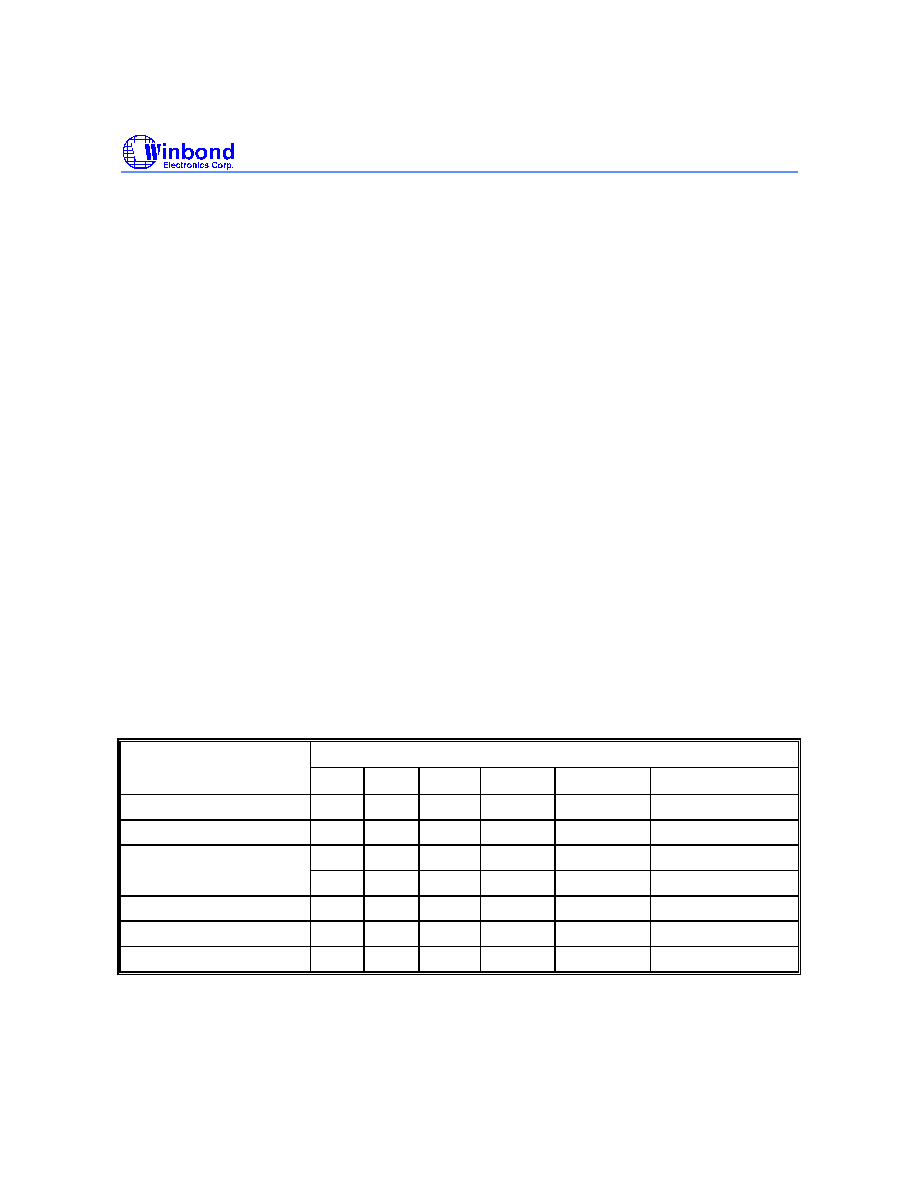
W49F002U
Publication Release Date: February 21, 2002
- 7 - Revision A6
For chip erase, the Data Polling is valid after the rising edge of the sixth pulse in the six #WE write
pulse sequence. For sector erase, the Data Polling is valid after the last rising edge of the sector erase
#WE pulse.
Just prior to the completion of Embedded Algorithm operations DQ7 may change asynchronously while
the output enable (#OE) is asserted low. This means that the device is driving status information on
DQ7 at one instant of time and then that byte
s valid data at the next instant of time. Depending on
when the system samples the DQ7 output, it may read the status or valid data. Even if the device has
completed the Embedded Algorithm operations and DQ7 has a valid data, the data outputs on DQ0 ≠
DQ6 may be still invalid. The valid data on DQ0
-
DQ7 will be read on the successive read attempts.
The Data Polling feature is only active during the Embedded Programming Algorithm, Embedded
Erase Algorithm, or sector erase time-out (see "Command Definitions").
See " #DATA Polling During Embedded Algorithm Timing Diagrams".
DQ6: Toggle Bit
The W49F002U also features the "Toggle Bit" as a method to indicate to the host system that the
embedded algorithms are in progress or completed.
During an Embedded Program or Erase Algorithm cycle, successive attempts to read (#OE toggling)
data from the device at any address will result in DQ6 toggling between one and zero. Once the
Embedded Program or Erase Algorithm cycle is completed, DQ6 will stop toggling and valid data will
be read on the next successive attempt. During programming, the Toggle Bit is valid after the rising
edge of the fourth #WE pulse in the four write pulse sequence. For chip erase, the Toggle Bit is valid
after the rising edge of the sixth #WE pulse in the six write pulse sequence. For Sector erase, the
Toggle Bit is valid after the last rising edge of the sector erase #WE pulse. The Toggle Bit is active
during the sector erase time-out.
TABLE OF OPERATING MODES
Device Bus Operations
MODE
PIN
#CE #OE
#WE #RESET A0
-
A17
DQ0
-
DQ7
Read
V
IL
V
IL
V
IH
V
IH
Ain
Dout
Write
V
IL
V
IH
V
IL
V
IH
Ain
Din
Write Inhibit
V
IH
X
V
IL
X
X
High Z/DOUT
V
IH
X
X
V
IH
X
High Z/DOUT
Standby
V
IH
X
X
V
IH
X
High Z
Output Disable
V
IL
V
IH
V
IH
V
IH
X
High Z
Reset
X
X
X
V
IL
X
High Z

W49F002U
- 8 -
Auto-select Codes (High Voltage Method)
DESCRIPTION
#CE
#OE
#WE
OTHER
ADD
A9
A1
A0
DQ7
TO DQ0
Manufacturer ID: Winbond
V
IL
V
IL
V
IH
X
V
ID
V
IL
V
IL
DAh
Device ID: W49F002U
(Top Boot Block)
V
IL
V
IL
V
IH
X
V
ID
V
IL
V
IH
0Bh
Notes:
1. SA = Sector Address, X = Don
t Care. Sector Protection Verification: 01h (protected); 00h (unprotected).
2. The hardware SID read function is not included in all parts; please refer to Ordering Information for details.
Hardware Sequence Flags
OPERATION
DQ7
DQ6
(Note)
Embedded Program Algorithm
#DQ7
Toggle
Standard Mode
Embedded Erase Algorithm
0
Toggle
Note: DQ7 require a valid address when reading status information. Refer to the appropriate subsection for further details.
Command Definition
(1)
COMMAND
No. of
1th Cycle
2nd Cycle
3rd Cycle
4th Cycle
5th Cycle
6th Cycle
DESCRIPTION
Cycles
Addr. Data
Addr. Data Addr. Data Addr. Data
Addr. Data Addr. Data
Read
1
AIN DOUT
Chip Erase
6
5555 AA 2AAA 55 5555 80 5555 AA 2AAA 55 5555 10
Sector Erase
6
5555 AA 2AAA 55 5555 80 5555 AA 2AAA 55 SA
(3)
30
Byte Program
4
5555 AA 2AAA 55 5555 A0 AIN DIN
Boot Block Lockout
6
5555 AA 2AAA 55 5555 80 5555 AA 2AAA 55 5555 40
Product ID Entry
3
5555 AA 2AAA 55 5555 90
Product ID Exit
(2)
3
5555 AA 2AAA 55 5555 F0
Product ID Exit
(2)
1
XXXX F0
Notes:
1. Address Format: A14
-
A0 (Hex); Data Format: DQ7
-
DQ0 (Hex)
2. Either one of the two Product ID Exit commands can be used.
3. SA means: Sector Address
If SA is within 3C000 to 3FFFF (Boot Block address range), and the Boot Block programming lockout feature is activated,
nothing will happen and the device will go back to read mode after 100nS.
If the Boot Block programming lockout feature is not activated, this command will erase Boot Block.
If SA is within 3A000 to 3BFFF (Parameter Block1 address range), this command will erase PB1.
If SA is within 38000 to 39FFF (Parameter Block2 address range), this command will erase PB2.
If SA is within 20000 to 37FFF (Main Memory Block1 address range), this command will erase MMB1.
If SA is within 00000 to 1FFFF (Main Memory Block2 address range), this command will erase MMB2.

W49F002U
Publication Release Date: February 21, 2002
- 9 - Revision A6
Embedded Programming Algorithm
Start
Write Program Command Sequence
(see below)
Increment Address
Programming Completed
5555H/AAH
2AAAH/55H
5555H/A0H
Program Address/Program Data
#Data Polling/ Toggle bit
Last Address
?
No
Yes
Program Command Sequence (Address/Command):
Pause T
BP

W49F002U
- 10 -
Embedded Erase Algorithm
Start
Write Erase Command Sequence
(see below)
Erasure Completed
#Data Polling or Toggle Bit
Successfully Completed
Chip Erase Command Sequence
5555H/AAH
5555H/AAH
2AAAH/55H
2AAAH/55H
5555H/80H
5555H/10H
(Address/Command):
5555H/AAH
5555H/AAH
2AAAH/55H
2AAAH/55H
5555H/80H
Sector Address/30H
(Address/Command):
Individual Sector Erase
Command Sequence
Pause T
EC
/T
SEC

W49F002U
Publication Release Date: February 21, 2002
- 11 - Revision A6
Embedded #Data Polling Algorithm
Start
Read Byte
(DQ0 - DQ7)
Address = VA
Pass
DQ7 = Data
?
Yes
No
VA = Byte address for programming
= Any of the sector addresses within
the sector being erased during sector
erase operation
= Valid address equals any sector group
address during chip erase
Embedded Toggle Bit Algorithm
Start
Read Byte
(DQ0 - DQ7)
Address = Don't Care
DQ6 = Toggle
?
Yes
No
Pass

W49F002U
- 12 -
Software Product Identification and Boot Block Lockout Detection Acquisition
Flow
Product
Identification
Entry (1)
Load data 55
to
address 2AAA
Load data 90
to
address 5555
Pause 10 S
Product
Identification
and Boot Block
Lockout Detection
Mode (3)
Read address = 0000
data = 00DA
Read address = 0001
data = 00AE
Read address = 0002
data in DQ0 =1/0
(4)
Product
Identification Exit(6)
Load data 55
to
address 2AAA
Load data F0
to
address 5555
Normal Mode
(5)
(2)
(2)
Load data AA
to
address 5555
µ
Load data AA
to
address 5555
Pause 10 S
µ
Notes for software product identification/boot block lockout detection:
(1) Data Format: DQ15
-
DQ8 (Don't Care), DQ7
-
DQ0 (Hex); Address Format: A14
-
A0 (Hex)
(2) A1
-
A16 = V
IL
; manufacture code is read for A0 = V
IL
; device code is read for A0 = V
IH
.
(3) The device does not remain in identification and boot block lockout detection mode if power down.
(4) If the output data in DQ0 = 1, the boot block programming lockout feature is activated; if the output data in DQ0 = 0, the lockout feature is
inactivated and the block can be programmed.
(5) The device returns to standard operation mode.
(6) Optional 1-write cycle (write F0 hex at XXXX address) can be used to exit the product identification/boot block lockout detection.
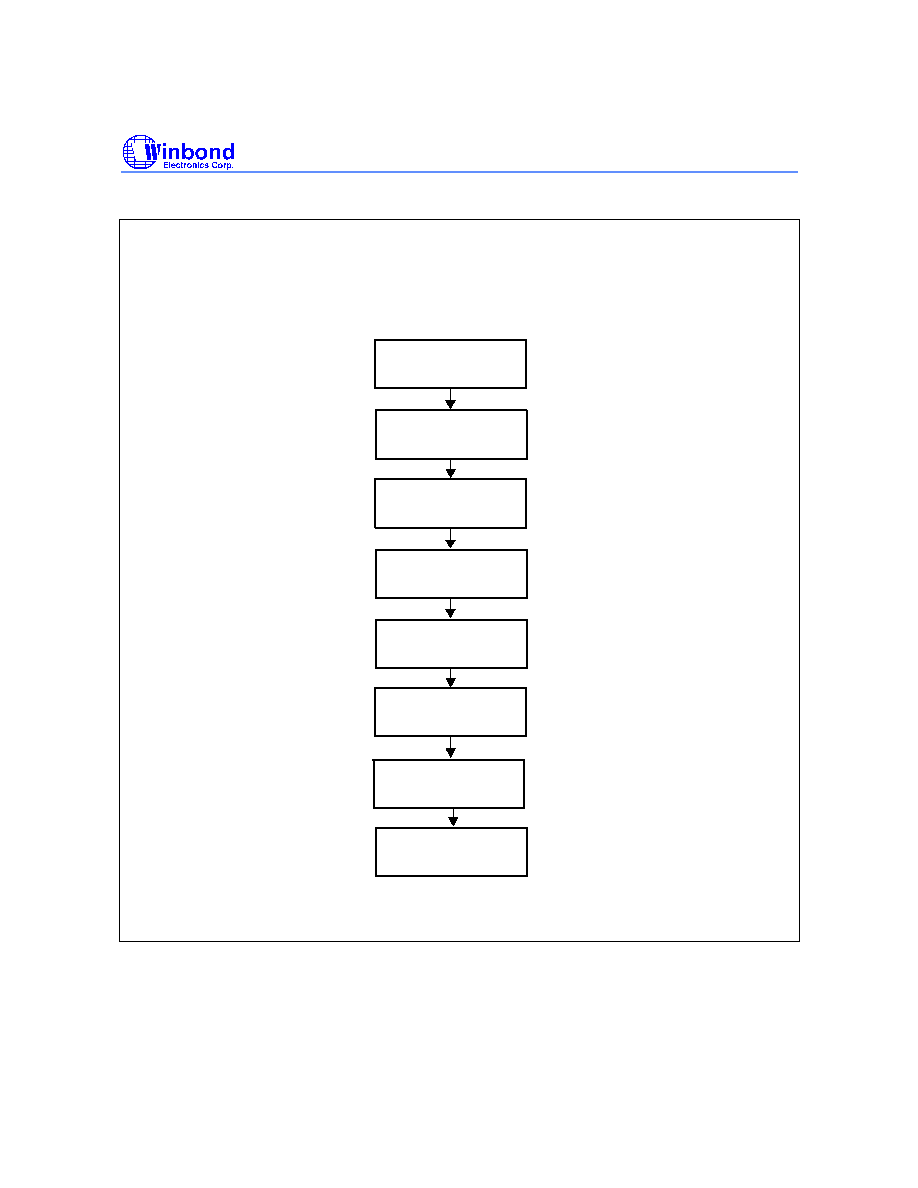
W49F002U
Publication Release Date: February 21, 2002
- 13 - Revision A6
Boot Block Lockout Enable Acquisition Flow
Boot Block Lockout
Feature Set Flow
Load data AA
to
address 5555
Load data 55
to
address 2AAA
Load data 80
to
address 5555
Load data AA
to
address 5555
Load data 55
to
address 2AAA
Load data 40
to
address 5555
Pause 200 mS
Exit

W49F002U
- 14 -
DC CHARACTERISTICS
Absolute Maximum Ratings
PARAMETER
RATING
UNIT
Power Supply Voltage to Vss
Potential
-0.5 to +7.0
V
Operating Temperature
0 to +70
∞
C
Storage Temperature
-65 to +150
∞
C
D.C. Voltage on Any Pin to Ground Potential Except A9
-0.5 to V
DD
+1.0
V
Transient Voltage (<20 nS) on Any Pin to Ground Potential
-1.0 to V
DD
+1.0
V
Voltage on A9 Pin to Ground Potential
-0.5 to 12.5
V
Note: Exposure to conditions beyond those listed under Absolute Maximum Ratings may adversely affect the life and reliability
of the device.
DC Operating Characteristics
(V
DD
= 5.0V
±
10
%
, V
SS
= 0V, T
A
= 0 to 70
∞
C)
PARAMETER
SYM.
TEST CONDITIONS
LIMITS
UNIT
MIN. TYP. MAX.
Power Supply
Current
I
CC
#CE = #OE = V
IL
, #WE = V
IH
,
all DQs open
Address inputs = V
IL
/V
IH
, at f = 5 MHz
-
25
50
mA
Standby V
DD
Current
(TTL input)
I
SB
1
#CE = V
IH
, all DQs open
Other inputs = V
IL
/V
IH
-
2
3
mA
Standby V
DD
Current
(CMOS input)
I
SB
2 #CE = V
DD
-0.3V, all DQs open
Other inputs = V
DD
-0.3V/ Vss
-
20
100
µ
A
Input Leakage
Current
I
LI
V
IN
= Vss to V
DD
-
-
10
µ
A
Output Leakage
Current
I
LO
V
OUT
= Vss to V
DD
-
-
10
µ
A
Input Low Voltage
V
IL
-
-0.3
-
0.8
V
Input High Voltage
V
IH
-
2.0
- V
DD
+0.5 V
Output Low Voltage
V
OL
I
OL
= 2.1 mA
-
-
0.45
V
Output High Voltage V
OH
I
OH
= -0.4 mA
2.4
-
-
V
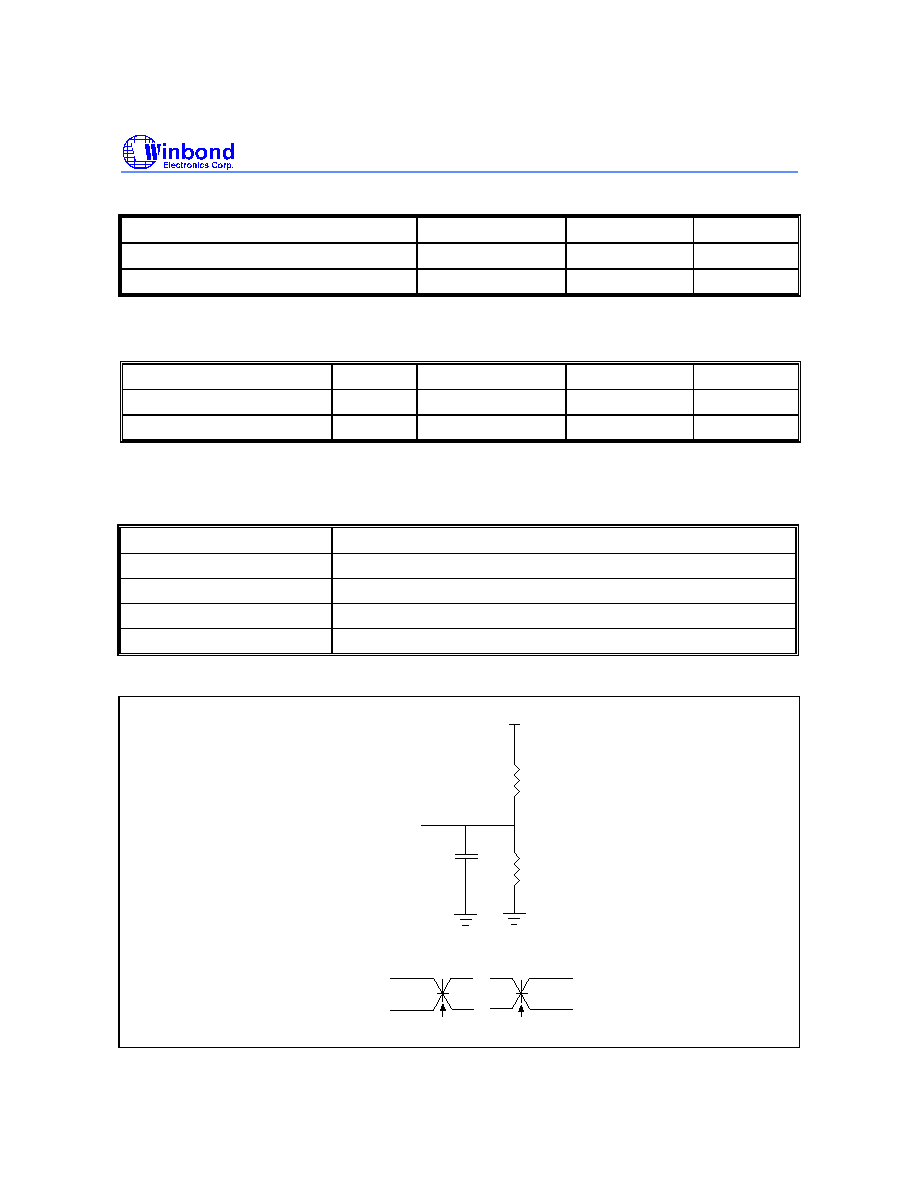
W49F002U
Publication Release Date: February 21, 2002
- 15 - Revision A6
Power-up Timing
PARAMETER
SYMBOL
TYPICAL
UNIT
Power-up to Read Operation
T
PU
. READ
100
µ
S
Power-up to Write Operation
T
PU
. WRITE
5
mS
CAPACITANCE
(V
DD
= 5.0V, T
A
= 25
∞
C, f = 1 MHz)
PARAMETER
SYMBOL
CONDITIONS
MAX.
UNIT
I/O Pin Capacitance
C
I/O
V
I/O
= 0V
12
pF
Input Capacitance
C
IN
V
IN
= 0V
6
pF
AC CHARACTERISTICS
AC Test Conditions
PARAMETER
CONDITIONS
Input Pulse Levels
0V to 3V
Input Rise/Fall Time
<5 nS
Input/Output Timing Level
1.5V / 1.5V
Output Load
1 TTL Gate and C
L
= 30pF (for 70 nS/ 90 nS), 100 pF (for 120 nS)
AC Test Load and Waveform
+5V
1.8K
1.3K
D
OUT
30 pF for 70nS / 90nS
(Including Jig and Scope)
Input
3V
0V
Test Point
Test Point
1.5V
1.5V
Output
100 pF for 120nS

W49F002U
- 16 -
AC Characteristics, continued
Read Cycle Timing Parameters
(V
DD
= 5.0V
±
10%, V
DD
= 0V, T
A
= 0 to 70
∞
C)
PARAMETER
SYM. W49F002U-70 W49F002U-90 W49F002U-120 UNIT
MIN. MAX. MIN. MAX. MIN. MAX.
Read Cycle Time
T
RC
70
-
90
-
120
-
nS
Chip Enable Access Time
T
CE
-
70
-
90
-
120
nS
Address Access Time
T
AA
-
70
-
90
-
120
nS
Output Enable Access Time
T
OE
-
35
-
40
-
50
nS
#CE Low to Active Output
T
CLZ
0
-
0
-
0
-
nS
#OE Low to Active Output
T
OLZ
0
-
0
-
0
-
nS
#CE High to High-Z Output
T
CHZ
-
25
-
25
-
30
nS
#OE High to High-Z Output
T
OHZ
-
25
-
25
-
30
nS
Output Hold from Address Change
T
OH
0
-
0
-
0
-
nS
Write Cycle Timing Parameters
PARAMETER
SYMBOL
MIN.
TYP.
MAX.
UNIT
Address Setup Time
T
AS
0
-
-
nS
Address Hold Time
T
AH
50
-
-
nS
#WE and #CE Setup Time
T
CS
0
-
-
nS
#WE and #CE Hold Time
T
CH
0
-
-
nS
#OE High Setup Time
T
OES
0
-
-
nS
#OE High Hold Time
T
OEH
0
-
-
nS
#CE Pulse Width
T
CP
100
-
-
nS
#WE Pulse Width
T
WP
100
-
-
nS
#WE High Width
T
WPH
100
-
-
nS
Data Setup Time
T
DS
50
-
-
nS
Data Hold Time
T
DH
10
-
-
nS
Byte Programming Time
T
BP
-
35
50
µ
S
Erase Cycle Time
T
EC
-
0.1
0.2
S
Note: All AC timing signals observe the following guidelines for determining setup and hold times:
(a) High level signal's reference level is V
IH
and (b) low level signal's reference level is V
IL
.

W49F002U
Publication Release Date: February 21, 2002
- 17 - Revision A6
AC Characteristics, continued
Data Polling and Toggle Bit Timing Parameters
PARAMETER
SYM. W49F002U-70 W49F002U-90 W49F002U-120 UNIT
MIN. MAX. MIN. MAX. MIN. MAX.
#OE to Data Polling Output Delay T
OEP
-
35
-
40
-
50
nS
#CE to Data Polling Output Delay
T
CEP
-
70
-
90
-
120
nS
#OE to Toggle Bit Output Delay
T
OET
-
35
-
40
-
50
nS
#CE to Toggle Bit Output Delay
T
CET
-
70
-
90
-
120
nS
Reset Timing Parameters
PARAMETER
SYMBOL
MIN.
TYP.
MAX.
UNIT
V
DD
stable to Reset Active
T
PRST
1
-
-
mS
Reset Pulse Width
T
RSTP
500
-
-
nS
Reset Active to Output Float
T
RSTF
-
-
50
nS
Reset Inactive to Input Active
T
RST
1
-
-
µ
S
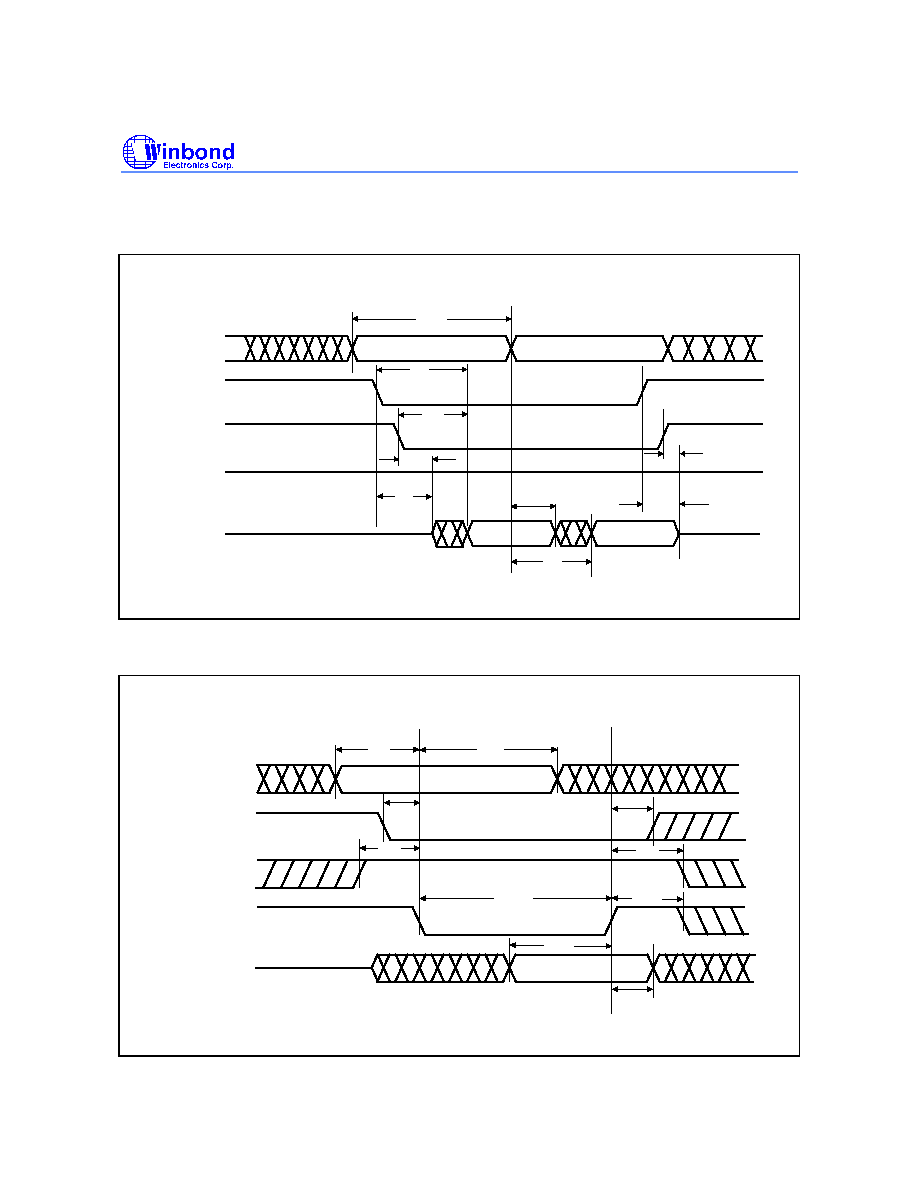
W49F002U
- 18 -
TIMING WAVEFORMS
Read Cycle Timing Diagram
Address A17-0
DQ7-0
Data Valid
Data Valid
High-Z
#CE
#OE
#WE
T
RC
V
IH
T
CLZ
T
OLZ
T
OE
T
CE
T
OH
T
AA
T
CHZ
T
OHZ
High-Z
#WE Controlled Command Write Cycle Timing Diagram
#CE
#OE
#WE
T
CS
T
OES
T
CH
T
OEH
T
WPH
T
WP
T
DS
DQ7-0
Data Valid
T
DH
Address A17-0
T
AS
T
AH

W49F002U
Publication Release Date: February 21, 2002
- 19 - Revision A6
Timing Waveforms, continued
#CE Controlled Command Write Cycle Timing Diagram
High Z
Data Valid
#CE
#OE
#WE
DQ7-0
T
AS
T
AH
T
CPH
T
OEH
T
DH
T
DS
T
CP
T
OES
Address A17-0
Program Cycle Timing Diagram
Address A17-0
Byte 0
Byte 1
Byte 2
Internal Write Start
DQ7-0
#CE
#OE
#WE
Byte Program Cycle
T
BP
T
WPH
T
WP
5555
5555
2AAA
AA
A0
55
Address
Data-In
Byte 3
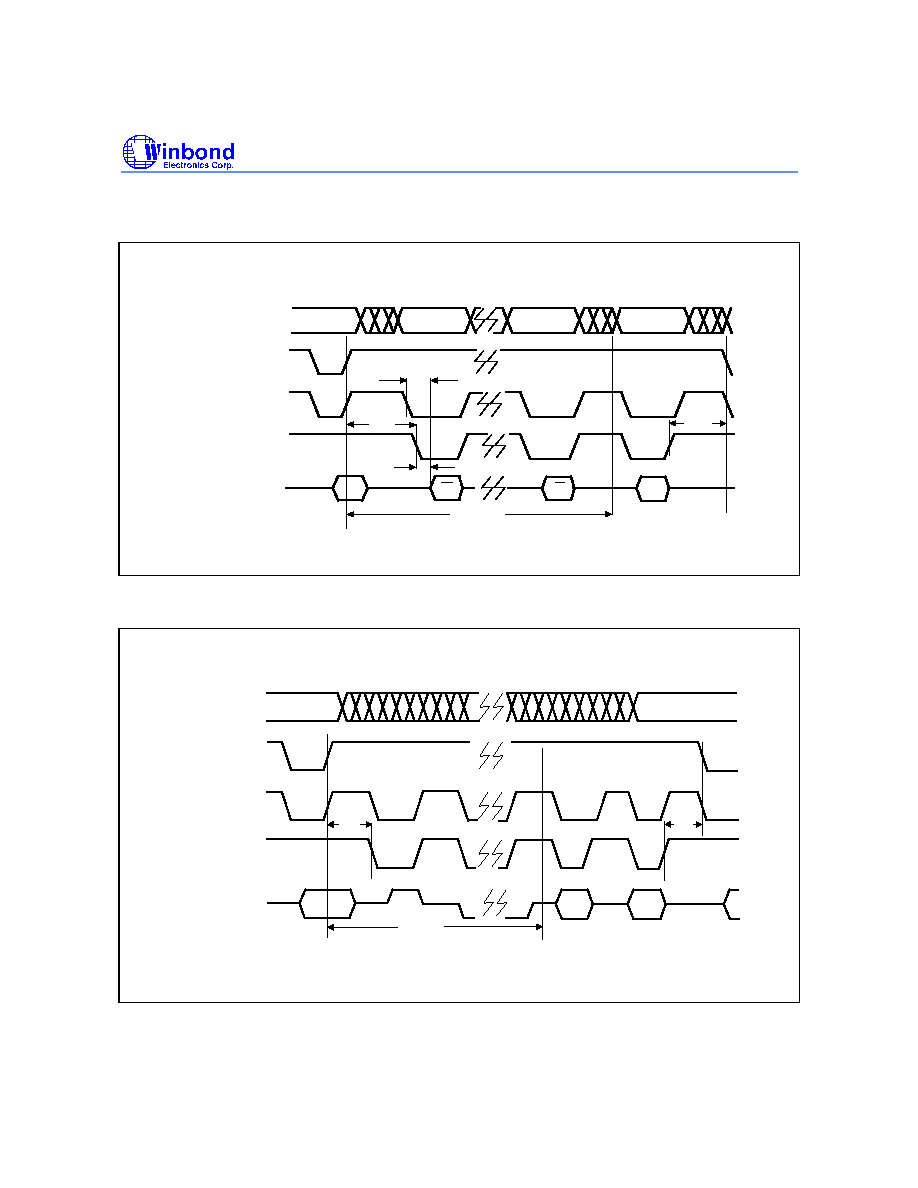
W49F002U
- 20 -
Timing Waveforms, continued
#DATA Polling Timing Diagram
Address A17-0
DQ7
#WE
#OE
#CE
X
X
X
X
T
CEP
T
OEH
T
OEP
T
OES
T
EC
T
BP or
An
An
An
An
Toggle Bit Timing Diagram
Address A17-0
DQ6
#CE
#OE
#WE
T
OEH
T
OES
T
BP or
T
EC

W49F002U
Publication Release Date: February 21, 2002
- 21 - Revision A6
Timing Waveforms, continued
Boot Block Lockout Enable Timing Diagram
SB2
SB1
SB0
Address A17-0
DQ7-0
#CE
#OE
#WE
SB3
SB4
SB5
Six byte code for Boot Block
Lockout Feature Enable
T
EC
T
WP
T
WPH
5555
2AAA
5555
5555
2AAA
5555
AA
55
80
AA
55
40
Chip Erase Timing Diagram
SB2
SB1
SB0
Address A17-0
DQ7-0
#CE
#OE
#WE
SB3
SB4
SB5
Internal Erase starts
Six-byte code for 5V-only software
chip erase
T
WP
T
WPH
T
EC
5555
2AAA
5555
5555
2AAA
5555
AA
55
80
AA
55
10
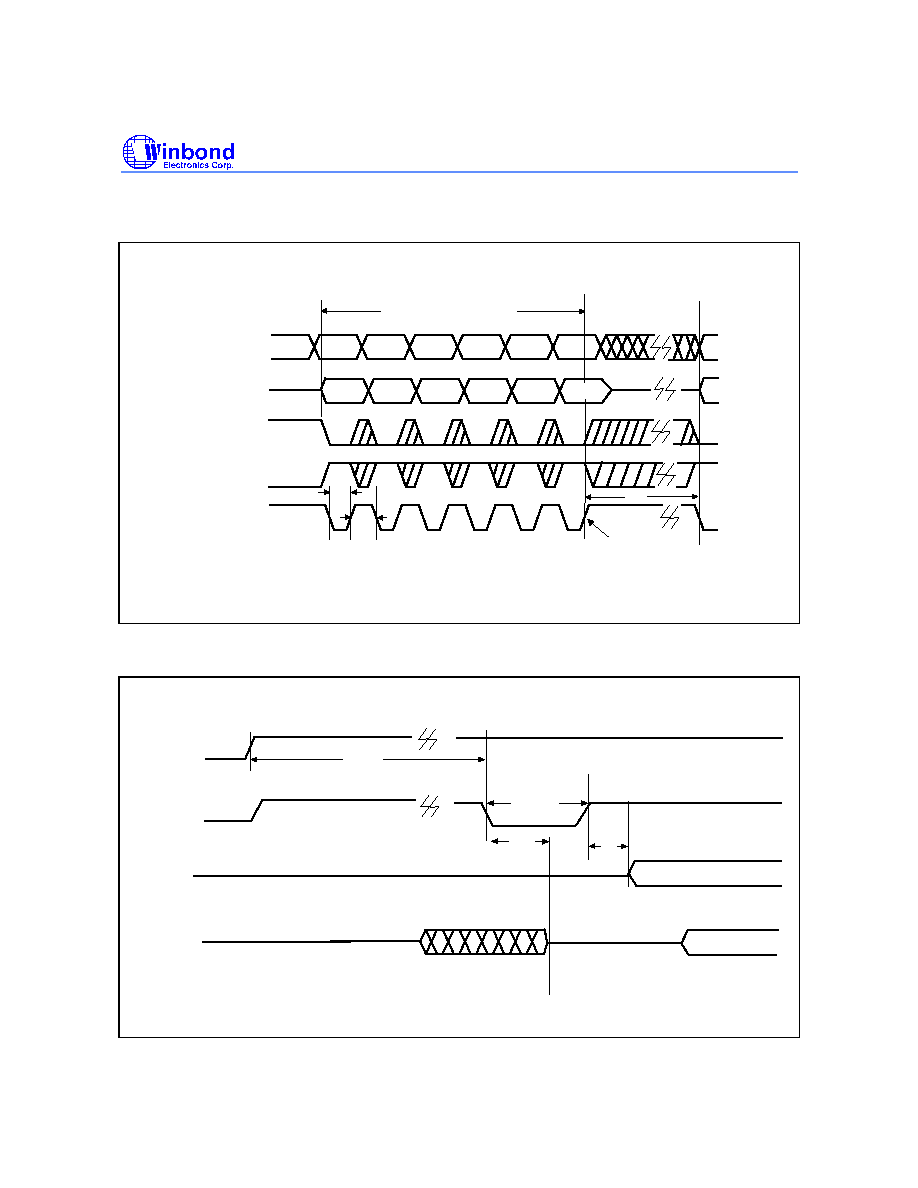
W49F002U
- 22 -
Timing Waveforms, continued
Sector Erase Timing Diagram
SB2
SB1
SB0
Address A17-0
DQ7-0
#CE
#OE
#WE
SB3
SB4
SB5
Internal Erase starts
Six-byte code for 5V-only software
Main Memory Erase
T
WP
T
WPH
T
EC
5555
2AAA
5555
5555
2AAA
SA
AA
55
80
AA
55
30
SA = Sector Address
Reset Timing Diagram
T
RSTP
VDD
T
PRST
#RESET
DQ7-0
T
RSTF
T
RST
Address A17-0
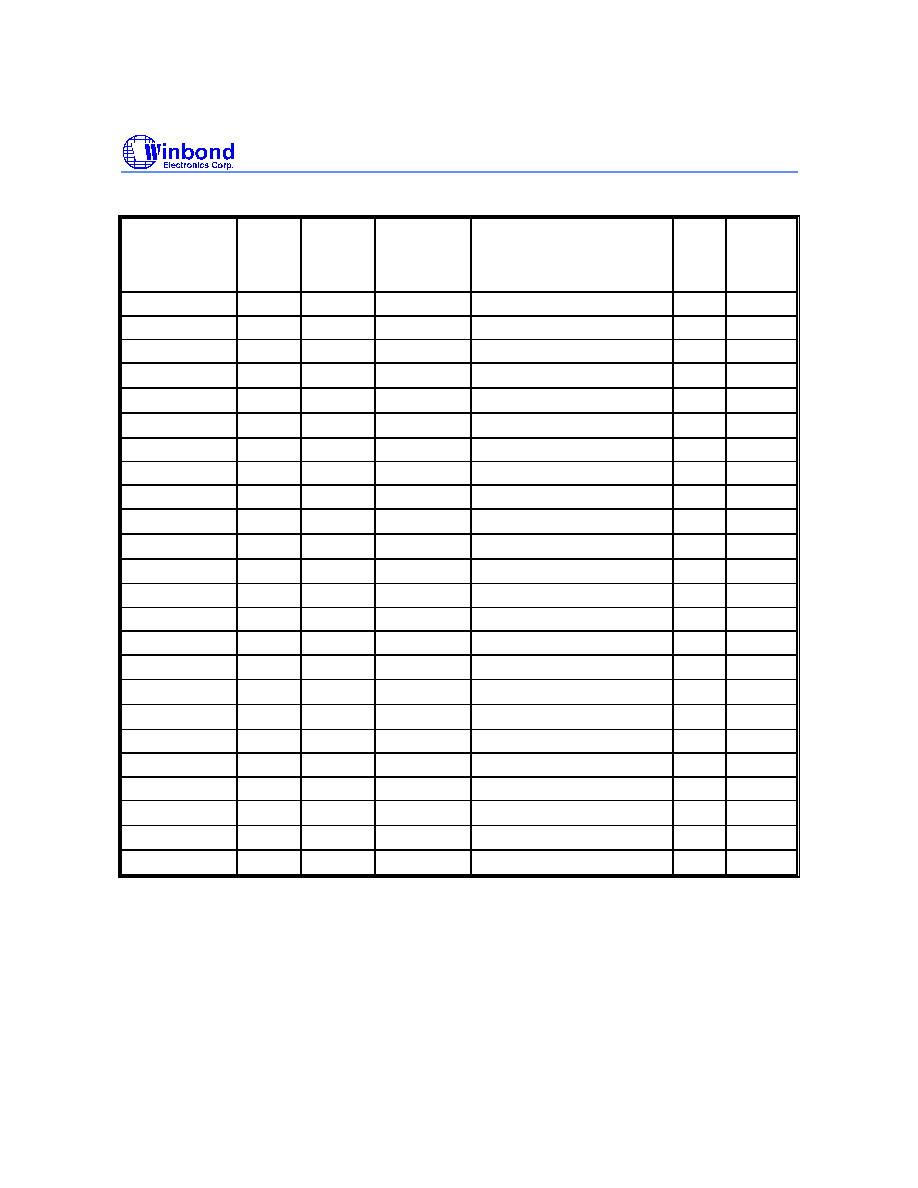
W49F002U
Publication Release Date: February 21, 2002
- 23 - Revision A6
ORDERING INFORMATION
PART NO.
ACCESS
TIME
(nS)
POWER
SUPPLY
CURRENT
MAX. (mA)
STANDBY
V
DD
CURRENT
MAX. (
µ
A)
PACKAGE
CYCLE
HARDWARE
SID READ
FUNCTION
W49F002U-70B
70
50
100 (CMOS) 32-pin DIP
10K
Y
W49F002U-90B
90
50
100 (CMOS) 32-pin DIP
10K
Y
W49F002U-12B
120
50
100 (CMOS) 32-pin DIP
10K
Y
W49F002UT70B
70
50
100 (CMOS) 32-pin TSOP (8 mm
◊
20 mm)
10K
Y
W49F002UT90B
90
50
100 (CMOS) 32-pin TSOP (8 mm
◊
20 mm)
10K
Y
W49F002UT12B
120
50
100 (CMOS) 32-pin TSOP (8 mm
◊
20 mm)
10K
Y
W49F002UP70B
70
50
100 (CMOS) 32-pin PLCC
10K
Y
W49F002UP90B
90
50
100 (CMOS) 32-pin PLCC
10K
Y
W49F002UP12B
120
50
100 (CMOS) 32-pin PLCC
10K
Y
W49F002UQ70B
70
50
100 (CMOS) 32-pin STSOP (8 mm
◊
14 mm) 10K
Y
W49F002UQ90B
90
50
100 (CMOS) 32-pin STSOP (8 mm
◊
14 mm) 10K
Y
W49F002UQ12B
120
50
100 (CMOS) 32-pin STSOP (8 mm
◊
14 mm) 10K
Y
W49F002U70BN
70
50
100 (CMOS) 32-pin DIP
10K
N
W49F002U90BN
90
50
100 (CMOS) 32-pin DIP
10K
N
W49F002U12BN
120
50
100 (CMOS) 32-pin DIP
10K
N
W49F002UT70N
70
50
100 (CMOS) 32-pin TSOP (8 mm
◊
20 mm)
10K
N
W49F002UT90N
90
50
100 (CMOS) 32-pin TSOP (8 mm
◊
20 mm)
10K
N
W49F002UT12N
120
50
100 (CMOS) 32-pin TSOP (8 mm
◊
20 mm)
10K
N
W49F002UP70N
70
50
100 (CMOS) 32-pin PLCC
10K
N
W49F002UP90N
90
50
100 (CMOS) 32-pin PLCC
10K
N
W49F002UP12N
120
50
100 (CMOS) 32-pin PLCC
10K
N
W49F002UQ70N
70
50
100 (CMOS) 32-pin STSOP (8 mm
◊
14 mm) 10K
N
W49F002UQ90N
90
50
100 (CMOS) 32-pin STSOP (8 mm
◊
14 mm) 10K
N
W49F002UQ12N
120
50
100 (CMOS) 32-pin STSOP (8 mm
◊
14 mm) 10K
N
Notes:
1. Winbond reserves the right to make changes to its products without prior notice.
2. Purchasers are responsible for performing appropriate quality assurance testing on products intended for use in
applications where personal injury might occur as a consequence of product failure.
3. Winbond offers Top Boot Block device, if any of Bottom Boot Block devices is required, please contact Winbond FAEs.
4. In Hardware SID read function column: Y = with SID read function; N = without SID read function.
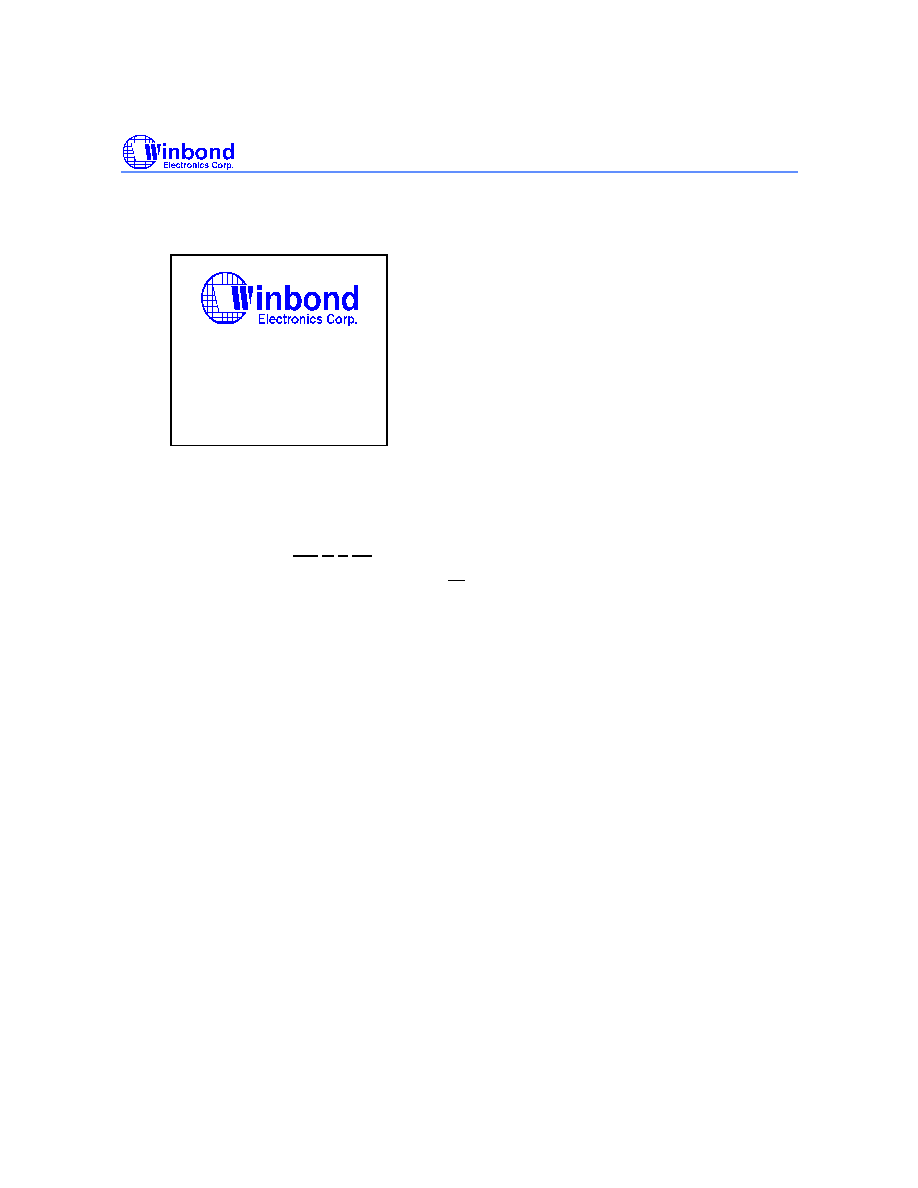
W49F002U
- 24 -
HOW TO READ THE TOP MARKING
Example: The top marking of 48-pin TSOP W49F002UT70B
1
st
line: winbond logo
2
nd
line: the part number: W49F002UT70B
3
rd
line: the lot number
4
th
line: the tracking code: 149 O B SA
149: Packages made in '01, wee k 49
O: Assembly house ID: A means ASE, O means OSE, ...etc.
B: IC revision; A means version A, B means version B, ...etc.
SA: Process code
W49F002UT70B
2138977A-A12
149OBSA

W49F002U
Publication Release Date: February 21, 2002
- 25 - Revision A6
PACKAGE DIMENSIONS
32-pin P-DIP
1.Dimensions D Max. & S include mold flash or
tie bar burrs.
2.Dimension E1 does not include interlead flash.
3.Dimensions D & E1 include mold mismatch and
are determined at the mold parting line.
6.General appearance spec. should be based on
final visual inspection spec.
.
1.37
1.22
0.054
0.048
Notes:
Symbol
Min. Nom. Max.
Max.
Nom.
Min.
Dimension in inches
Dimension in mm
A
B
c
D
e
A
L
S
A
A
1
2
E
0.050
1.27
0.210
5.33
0.010
0.150
0.016
0.155
0.018
0.160
0.022
3.81
0.41
0.25
3.94
0.46
4.06
0.56
0.008
0.120
0.670
0.010
0.130
0.014
0.140
0.20
3.05
0.25
3.30
0.36
3.56
0.555
0.550
0.545
14.10
13.97
13.84
17.02
15.24
14.99
15.49
0.600
0.590
0.610
2.29
2.54
2.79
0.090
0.100
0.110
B
1
1
e
E
1
a
1.650
1.660
41.91
42.16
0
15
0.085
2.16
0.650
0.630
16.00
16.51
protrusion/intrusion.
4.Dimension B1 does not include dambar
5.Controlling dimension: Inches
15
0
Seating Plane
e
A
2
A
a
c
E
Base Plane
1
A
1
e
L
A
S
1
E
D
1
B
B
32
1
16
17
32-pin PLCC
Notes:
L
c
1
b
2
A
H
E
E
e
b
D H
D
y
A
A
1
Seating Plane
E
G
G
D
1
13
14
20
29
32
4
5
21
30
1. Dimensions D & E do not include interlead flash.
2. Dimension b1 does not include dambar protrusion/intrusion.
3. Controlling dimension: Inches
4. General appearance spec. should be based on final
visual inspection sepc.
Symbol
Min.
Nom.
Max.
Max.
Nom.
Min.
Dimension in Inches
Dimension in mm
A
b
c
D
e
H
E
L
y
A
A
1
2
E
b
1
G
D
3.56
0.50
2.80
2.67
2.93
0.71
0.66
0.81
0.41
0.46
0.56
0.20
0.25
0.35
13.89
13.97
14.05
11.35
11.43
11.51
1.27
H
D
G
E
12.45
12.9
5
13.46
9.91
10.41
10.92
14.86
14.99
15.11
12.32
12.45
12.57
1.91
2.29
0.004
0.095
0.090
0.075
0.495
0.49
0
0.485
0.595
0.590
0.585
0.430
0.410
0.390
0.530
0.51
0
0.490
0.050
0.453
0.450
0.447
0.553
0.550
0.547
0.014
0.010
0.008
0.022
0.018
0.016
0.032
0.026
0.028
0.115
0.105
0.110
0.020
0.140
1.12
1.42
0.044
0.056
0
∞
10
∞
10
∞
0
∞
0.10
2.41

W49F002U
- 26 -
Package Dimensions, continued
32-pin STSOP (8 x 14 mm)
Min.
Dimension in Inches
Nom. Max.
Min.
Nom. Max.
Symbol
1.20
0.05
0.15
1.05
1.00
0.95
0.17
0.10
0.50
0.00
0
0.22
0.27
-----
0.21
12.40
8.00
14.00
0.50
0.60
0.70
0.80
0.10
3
5
0.047
0.006
0.041
0.040
0.035
0.007
0.009
0.010
0.004
-----
0.008
0.488
0.315
0.551
0.020
0.020
0.024
0.028
0.031
0.000
0.004
0
3
5
0.002
A
A
b
c
D
E
e
L
L
Y
1
1
2
A
H
D
Dimension in mm
A
A
A
2
1
L
L
1
Y
E
H
D
D
c
£c
b
e
32-pin TSOP (8 x 20 mm)
A
A
A
2
1
L
L
1
Y
c
E
H
D
D
b
e
M
0.10(0.004)
Min.
Nom.
Max.
Min.
Nom.
Max.
Symbol
A
A
b
c
D
E
e
L
L
Y
1
1
2
A
H
D
Note:
Controlling dimension: Millimeters
Dimension in Inches
0.047
0.006
0.041
0.039
0.037
0.007
0.008
0.009
0.005
0.006
0.007
0.720
0.724
0.728
0.311
0.315
0.319
0.780
0.787
0.795
0.020
0.016
0.020
0.024
0.031
0.000
0.004
1
3
5
0.002
1.20
0.05
0.15
1.05
1.00
0.95
0.17
0.12
18.30
7.90
19.80
0.40
0.00
1
0.20
0.23
0.15
0.17
18.40
18.50
8.00
8.10
20.00
20.20
0.50
0.50
0.60
0.80
0.10
3
5
Dimension in mm
__
__
__
__
__
__
__
__
__
__
__
__
__
__
__
__
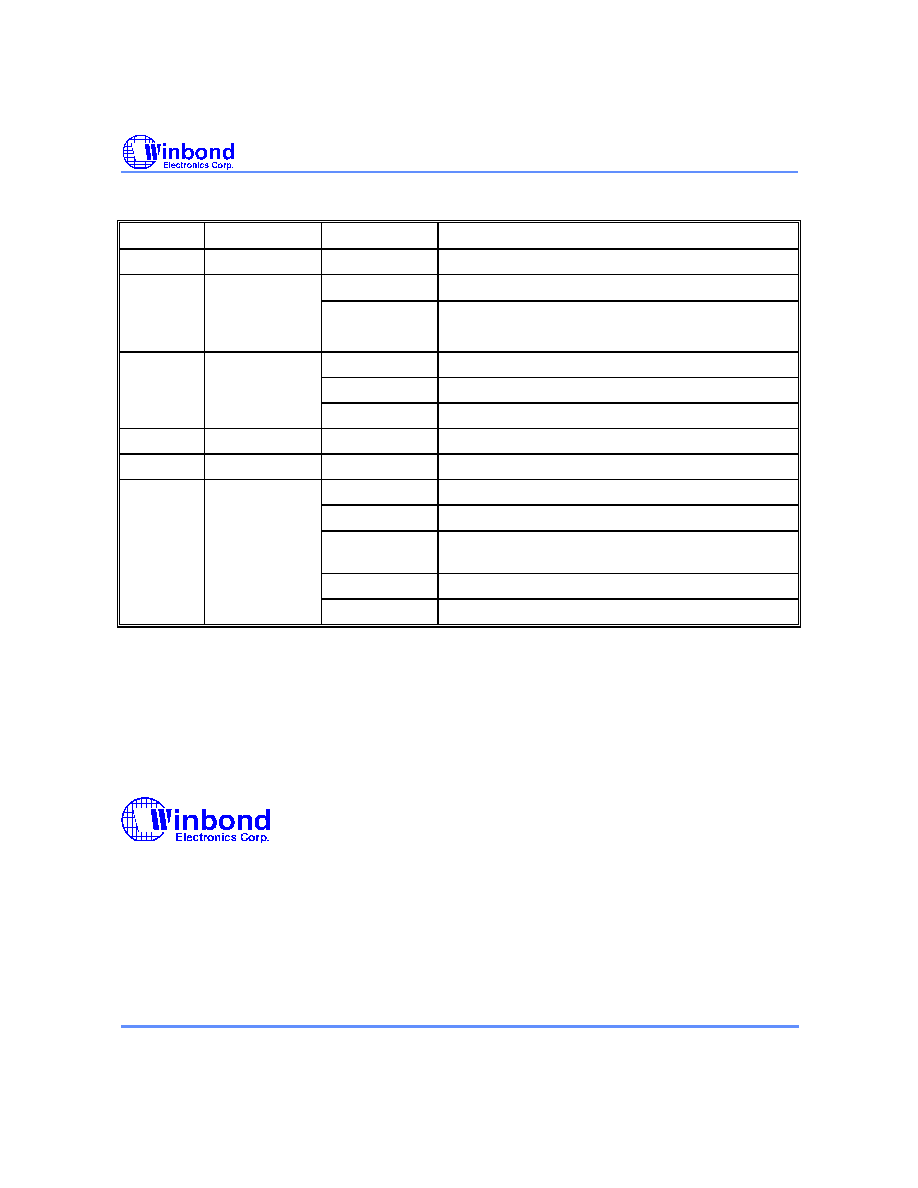
W49F002U
Publication Release Date: February 21, 2002
- 27 - Revision A6
VERSION HISTORY
VERSION
DATE
PAGE
DESCRIPTION
A1
Nov. 1999
-
Renamed from W49F002/B/U/N
A2
Apr. 2000
1, 13
-
15, 20 Add the 120 nS bin
14
Change Tbp(typ.) from 10
µ
S to 35
µ
S
Change Tec (max.) from 1 Sec to 0.2 Sec
A3
Dec. 2000
All
Modify some function description
3, 9, 25
Add in Hardware SID read note
1, 25, 27
Add in 32-pin TSOP (8 mm x 14 mm) package
A4
Jan. 2001
All
Typo correction
A5
Aug. 13, 2001
16,22
Add Reset Timing Parameters and Diagram
A6
Feb. 21, 2002
1, 25, 28
Rename STOP (8 x 14 mm) as STSOP (8 x 14 mm)
4
Modify Low V
DD
Write Inhibit description
13
Add in Software Product Identification and Boot
Block Lockout Detection Acquisition Flow
14
Add in Boot Block Lockout Enable Acquisition Flow
24
Add HOW TO READ THE TOP MARKING
Headquarters
No. 4, Creation Rd. III,
Science-Based Industrial Park,
Hsinchu, Taiwan
TEL: 886-3-5770066
FAX: 886-3-5665577
http://www.winbond.com.tw/
Taipei Office
TEL: 886-2-8177-7168
FAX: 886-2-8751-3579
Winbond Electronics Corporation America
2727 North First Street, San Jose,
CA 95134, U.S.A.
TEL: 1-408-9436666
FAX: 1-408-5441798
Winbond Electronics (H.K.) Ltd.
No. 378 Kwun Tong Rd.,
Kowloon, Hong Kong
FAX: 852-27552064
Unit 9-15, 22F, Millennium City,
TEL: 852-27513100
Please note that all data and specifications are subject to change without notice.
All the trade marks of products and companies mentioned in this data sheet belong to their respective owners.
Winbond Electronics (Shanghai) Ltd.
200336 China
FAX: 86-21-62365998
27F, 2299 Yan An W. Rd. Shanghai,
TEL: 86-21-62365999
Winbond Electronics Corporation Japan
Shinyokohama Kohoku-ku,
Yokohama, 222-0033
FAX: 81-45-4781800
7F Daini-ueno BLDG, 3-7-18
TEL: 81-45-4781881
9F, No.480, Rueiguang Rd.,
Neihu Chiu, Taipei, 114,
Taiwan, R.O.C.


























